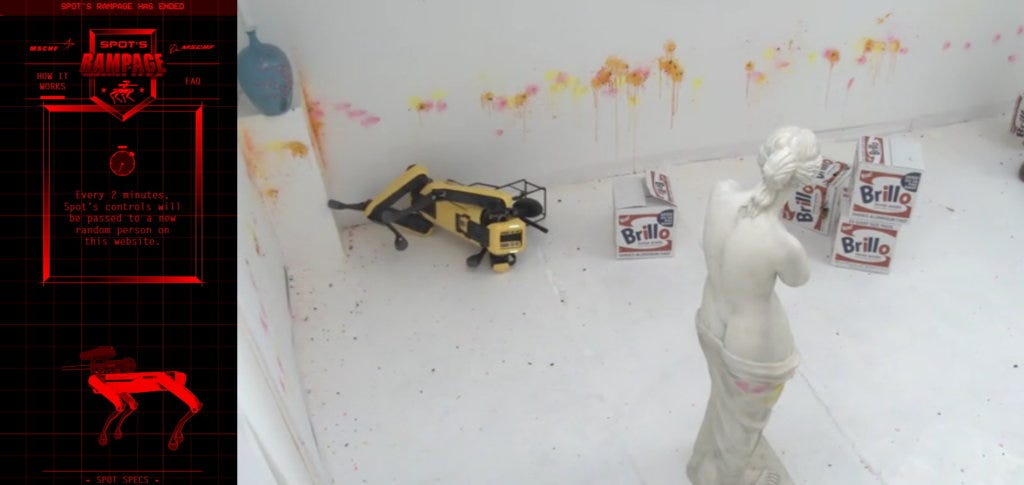Bodies Against Compression
That Apple Ad & Dancing with Hydraulics

We’re going to talk about an ad, so let’s get the product placement out of the way: Apple has a new, slim iPad, and Tim Cook is excited about how slim it is. You can go buy it if you’re looking for an iPad. But this is not a newsletter about product launches, it’s a newsletter that — at least some times — is about intersections of visual culture and technology. So I’d like to talk about the ad, an ad that has already been talked about online ad nauseum.
The ad visualizes a giant trash compactor rendered in a cold, almost medical-level sanitary steel, loaded with a thick slab of granite that may once have been the porch of a failed ‘70s brutalist architecture project. As a Sonny & Cher jam plays (“give me a reason to build a world around you…”) the slab is lowered on top of a pile of creative tools and projects.
First, a trumpet collapses like brass origami under the weight of the gray slab, paired with the distant sound of a badly played trumpet, as if the performer’s spirit has also been flattened. Then a copy of an arcade game cabinet, Space Imploder, flashing a “Game Over” message as it buckles beneath the slab.
We then crush cans of paint over a piano, a metronome, a clay sculpture, a series of camera lenses, a guitar. A pile of notebooks explodes, and then a wood model used for posing humans is bent over backward. The slab lands, purely flat on its pedestal, as nothing but paints bleeds from its edges. The song returns: “Come and follow rainbows … all I ever need is you.”
The ad reminded me of another series of viral videos, which were recently included in the Australian Triennale in Melbourne, in which the dancer Smac McCreanor performs alongside items being compressed by a hydraulic press.
The Apple ad would be McCreanor’s magnum opus. More on her work in a minute.
Compression
The backlash to the Apple ad was severe. The idea that technology has been reducing the need for multiple objects into a single interface is nothing new (there is even a shockingly similar 2008 ad for the phone company LG that used a trash compactor in the same way).
But in 2024, the response to the compression of human creativity was met with a collective disgust, with one proposed community note adding the context that “this is a violent and grotesque video” (the note was not accepted). Why did LG do it without any response in 2008 while Apple seems to have stirred up strong feelings of revulsion in 2024?
Part of it is the new context of Big Tech and generative AI. The ad is a perfect metaphor for the generative AI training process: squish it all — all! — into a model. All that stuff becomes one interface. It’s a reductive AI frame again, one in which human expression is fodder for products. This time, the product isn’t hidden behind the obfuscation of “artificial intelligence,” it is a physical product — just another iPad.
It’s a black box, slim and dull. One can picture your kids ignoring you to tap on it into their 30s. The instruments being compressed into this box are decidedly human, but also communal. You play a horn, guitar or piano for other people. Even the arcade console is something that allowed spectators. The human head sculpture and body models being crushed seem to send a signal — unintentionally, I am sure. The message is that art as a means of human collaboration and interaction are being replaced with a small, slim black screen: as the song says, “all I ever need is you.”
Data is always an abstraction, and the data of cultural production always cuts things away. While many argue that generative AI is copying and pasting the work of human creators, the reality is far more complex: AI training is stripping all context away from human creators, rendering it into precise points which form abstract categories through data points, the analysis of pixel colors and coordinates paired with labels.
The reality is that neither AI companies nor their models care, at all, about your past forms of creative expression. They simply need things to compress. Your past, our cultural memory, is grist for the mill. That process of compression has an aim: the creation of a black box, which serves as many needs as a company can monetize in ways that minimize human competition and collaboration that achieves the same ends — so that the lyrics “give me a reason to build a world around you,” are no longer meant for another person, but are being sung to an iPad.
This is, of course, the trend in automation. Even Google is less interested in creating links to websites in which we can find information, but would rather build a chatbot that serves as the central arbiter of information: a chorus of variability compressed into a single black box.
There are, of course, lots of neat things you can do with data. But data is a reductive process — a form of compression which shaves off edges, disconnects from entangled complexities and pretends that what we measure about the world can replace the world itself. That’s true with data analytics, and it’s true with generative AI.
Crush Me Like One Of Your Drawings of French Girls

I don’t look like it but I am fascinated by dance, particularly as it connects to the conversations about AI. Whereas the AI conversation is entirely cerebral, focusing exclusively on the so-called “rational mind” to model the world, dance serves up a rebuttal. There is a way of navigating the world that isn’t the mind: our bodies. It’s a painfully obvious point, but the body is an inconvenient point of data that machine learning so often excises from its models for the sake of reducing variability.
The body, then, is a form of resistance to networked, automated technological control. I was struck by another juxtaposition between bodies and their absence this month: a new company offering fake AI-generated followers that would “interact” with your TikTok and livestream feeds to inflate the illusion of an audience. The app was framed online as a tool for young men to impress women — walk up to them and tell them you’re a streamer with 300,000 followers and then you have their attention. Very normal, very healthy culture.
The “simulation of a mass audience app” came the same week as the student protests at campuses across the US, which are offered in solidarity with the people of Gaza. The response to this mobilization of actual bodies within space — as it always is — is the deployment of police and the subsequent deployment of violence against those students.
Contrasting these two stories reveals one more step in the forking paths for two futures: a withdrawal into AI-and-networks-assisted individualist fantasies of highly customizable and controllable social interactions, and its rebuttal: the periodic rediscovery of the power of collective embodiment in politics. These paths are strategies, not political positions themselves, and these strategies can be used regardless of the cause, or the value of a cause. The difference is that bodies matter, politically, while online solipsism matters very little. But AI companies make more money keeping us behind screens, which is convenient for any entrenched political power.
Which is a long way to go to talk about that Apple ad, and how it seems to say: you don’t need to have a body that moves through space anymore, because your ideas can express themselves through a screen.
Control is a factor of all political power, bodies are subject to all kinds of political philosophies. But bodies are subject to violence, while fantasies of disembodied data offer comforting affirmative illusions of power and social connection under the tight confines of algorithmic control: online activism does nothing, aside, perhaps, from encouraging people to mobilize their bodies and commit to action.
What makes McCreanor’s work so satisfying to me, in a poetic kind of way, is to read it as the innate rebellion of having a body within the confines of a techno-cultural politics that strives for disembodiment. It is ironic then that her work is known for being viral: bodies often are! So her work reads to me as simultaneously responsive, mocking, and outside of the reductive logic of compression. She dances with compression, her body taking its cues while standing apart from it.
I’m fascinated by this (literal and metaphorical) dance of adaptation-and-refusal in the context of Artificial Intelligence and online networks. And it brings me to something else, full circle: How an artist’s project about the destruction of culture raised the ire of a robotics company.
Spot’s Rampage

In “Clock, Fall,” a (highly recommended and engaging) keynote lecture at Harvard’s MetaLab, Sydney Skybetter discusses the entangled history of dance, AI, and robotics. Skybetter describes a project from the artist group, MSCHF, called Spot’s Rampage, in which a Boston Dynamics robot with a paint gun is placed inside a mock-up of an art gallery, full of faux Warhol’s and marble sculptures, which are controlled by internet users who can destroy the gallery’s content via livestream.
The robot went into severe malfunctioning and collapsed soon into the live stream. It’s suggested that Boston Dynamics remotely deactivated the robot in the installation after complaining about a violation of using the robot to promote violence.
Robots have a different set of priorities than AI companies: they occupy space, interact with bodies, and so the politics of embodiment still apply. So it is telling that an iPad pro can use the premise of Spot’s Rampage — that is, the violent destruction of human culture — as a marketing stunt; while robotics companies overreact to aggressively curtail it. There are differences, of course, but it’s telling that Apple is so far removed from the physicality of creativity, politics, and culture that acts of destruction can remain abstract, even fun.
Bodies and their presence complicate the logics of AI: they are an afterthought, and so, the body holds significant power. This is a cultural and aesthetic power — think of the distorted renderings of bodies so often created by generative AI systems — but also a political power, in that the simple presence of bodies can be seen as a threat to institutions in ways that online mobilization never could.
But chiefly it speaks to the idea of Silicon Valley that the material world is an afterthought, a place that we should strive to escape from. This world is complex, varied, and often discordant. Tech companies have a simple message: escape it; withdraw into your even-slimmer slice.

Stuff I Am Doing This Week
Folks seem to be asking, but I am not in London anymore. I’m excited to share a few events stateside that are coming up — some announcements in the works if you are near Boston, San Francisco, Melbourne or Providence! But for now I am resting up from an intense and delightful month at the Flickr Foundation in London and trying to write. But I did get this image of the Aurora Borealis over Lake Ontario in Rochester NY this week!






